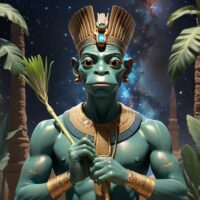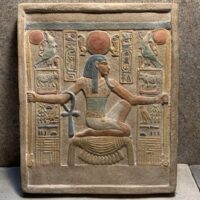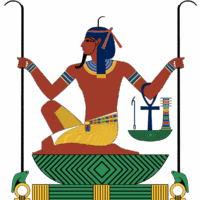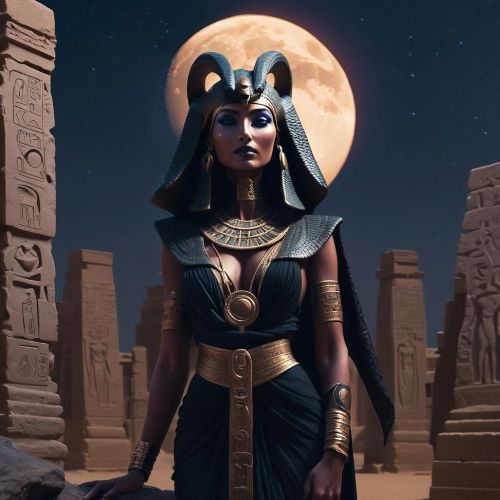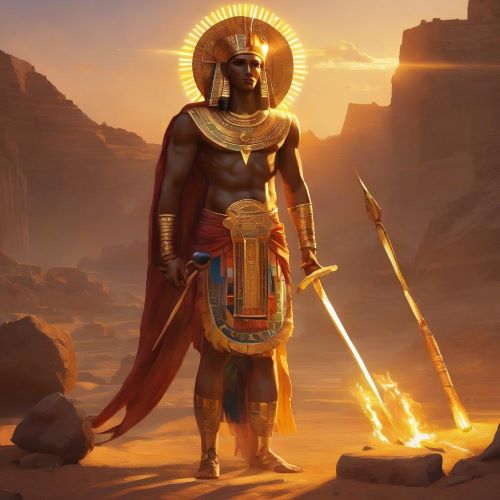Heh : God of Infinity
Listen
At a glance
| Description | |
|---|---|
| Origin | Egyptian Mythology |
| Classification | Gods |
| Family Members | Hauhet (Wife) |
| Region | Egypt |
| Associated With | Infinity, Eternity |
Heh
Introduction
In ancient Egyptian mythology, Heh stands as a profound symbol of infinity and the immeasurable nature of time. Revered as one of the primordial gods in the Ogdoad of Hermopolis, Heh wasn’t just a figure of mythology—he represented the vast, unending reality that existed before creation itself. To the Egyptians, Heh wasn’t simply a god; he was the embodiment of limitless potential and the eternal cycles of the cosmos.
Physical Traits
The imagery surrounding Heh is rich in symbolic meaning. Traditionally, he is shown as a man either standing or crouching, grasping one or two notched palm branches in his hands—powerful symbols of the passage of time. These fronds are often topped or accompanied by the shen ring, a circular emblem that represents eternity and completeness in Egyptian iconography.
Occasionally, particularly in his role within the Ogdoad, Heh is portrayed with a frog’s head or even in the form of a frog. This might seem peculiar at first glance, but frogs were seen as symbols of fertility, regeneration, and life due to their relationship with the Nile’s seasonal floods. This dual imagery—human and amphibian—captures the god’s dual role as both a stabilizing force and a being tied to the primal chaos before the world took shape. Another fascinating detail is that Heh is sometimes depicted seated on a basket. In Egyptian hieroglyphics, the basket symbol translates to “all” or “everything,” reinforcing his domain over the totality of time and space.
Family
Unlike many gods in the Egyptian pantheon who have extensive mythological stories, Heh belongs to a unique group of deities known as the Ogdoad. This group consists of four male-female pairs, each representing fundamental aspects of the pre-creation cosmos. Heh is paired with Hauhet (or Hehet), who shares his qualities of eternity but represents the feminine counterpart.
Together, Heh and Hauhet reflect the endless expanse of time. The other pairs in the Ogdoad represent dark (Kek and Kauket), hiddenness (Amun and Amaunet), and the primordial waters (Nun and Naunet). These concepts formed the building blocks of the universe before order was established. Heh and the rest of the Ogdoad were venerated in Hermopolis Magna, a major center of theological thought, where these deities were believed to have initiated the cosmic processes leading to the creation of the world.
Other names
The name Heh has appeared in several forms across various texts and inscriptions. Variants such as Huh, Hah, Hauh, Huah, and Hehu reflect regional dialects, changes in writing systems, and the fluidity of ancient Egyptian language over centuries. His name is often translated to mean “millions” or “flood,” further emphasizing his link to unending time and boundless potential. These linguistic variations didn’t change the essence of the god; they instead reflect the widespread reverence of Heh throughout different regions and time periods in Egypt’s long history.
Powers and Abilities
Heh’s divine power lay in his representation of infinity and eternal life. His presence in religious and royal imagery served as a powerful invocation of long life, especially for kings who wished for their rule and legacy to endure “millions of years.” Hieroglyphically, the raised arms of Heh signify a million—an astronomical number to the ancient Egyptians—making him a figure often carved or painted into tombs, funerary items, and temple walls as a wish for unending life. In King Tutankhamun’s tomb, for instance, Heh appears frequently alongside symbols of renewal and eternal reign.
Beyond the idea of longevity, Heh also played a subtle but essential role in maintaining cosmic order. He was sometimes associated with Shu, the god who held up the sky, and in this capacity, Heh helped support the heavens and maintain the balance between earth and the divine. His identity as a god of both time and structure places him at the intersection of chaos and order—an eternal presence ensuring that the universe continues its cyclical path. Heh’s conceptual reach even extended to cosmological creation myths. Alongside his fellow Ogdoad members, Heh was involved in the mythic birth of the primordial mound and cosmic egg, from which the sun god Re (Ra) emerged, bringing light and life to the world.
Modern Day Influence
While Heh may not be as widely recognized today as gods like Osiris or Anubis, his legacy still resonates in subtle and meaningful ways. The concept of infinity—once encapsulated in his image—is ever-present in modern symbolism, philosophy, and even mathematics. The idea of eternity, boundless potential, and the continuity of time remains as relevant today as it was in ancient Egypt.
His image, particularly the combination of the palm frond and shen ring, has found its way into modern jewelry, tattoos, and artistic designs—often as a symbol of eternal love, unbreakable cycles, or spiritual growth. Scholars and spiritual practitioners interested in ancient wisdom often invoke Heh in discussions about time, cosmic order, and metaphysical balance.
In Egyptology, Heh continues to be a subject of academic research and public fascination. Museums that display Egyptian artifacts often include items bearing his image, giving modern audiences a glimpse into how the ancients viewed time and the afterlife. Pop culture and media occasionally reference gods like Heh in fantasy, fiction, and speculative writing, where concepts of time, immortality, and the infinite are central themes. Though not always named directly, the archetype he represents continues to influence how we conceptualize the infinite.
Related Images
Source
Wilkinson, R. H. (2003). The Complete Gods and Goddesses of Ancient Egypt. Thames & Hudson.
Hornung, E. (1999). The Secret Lore of Egypt: Its Impact on the West. Cornell University Press.
Allen, J. P. (2015). The Ancient Egyptian Pyramid Texts. Society of Biblical Literature.
“Heh (god).” (2002). Wikipedia. https://en.wikipedia.org/wiki/Heh_(god)
“Heh and Hauhet, Deities of Infinity and Eternity.” (1996). Tour Egypt. https://www.touregypt.net/featurestories/heh.htm
Cedric Ferris. (2024). Heh: Ancient Egyptian Deity Of Infinity And Eternity. https://mysteryinhistory.com/heh/
“Heh and Hehet, God and Goddess of Infinity.” (2022). Iseum Sanctuary. https://iseumsanctuary.com/2022/01/19/heh-and-hehet-god-and-goddess-of-infinity/
“Heh.” (2019). The Mythology – Ancient Egypt. http://www.egyptianmyths.net/heh.htm
Britannica, T. Editors of Encyclopaedia. (2025). Heh. https://www.britannica.com/topic/Heh
Frequently Asked Questions
What is lorem Ipsum?
I am text block. Click edit button to change this text. Lorem ipsum dolor sit amet, consectetur adipiscing elit. Ut elit tellus, luctus nec ullamcorper mattis, pulvinar dapibus leo.
What is lorem Ipsum?
I am text block. Click edit button to change this text. Lorem ipsum dolor sit amet, consectetur adipiscing elit. Ut elit tellus, luctus nec ullamcorper mattis, pulvinar dapibus leo.
What is lorem Ipsum?
I am text block. Click edit button to change this text. Lorem ipsum dolor sit amet, consectetur adipiscing elit. Ut elit tellus, luctus nec ullamcorper mattis, pulvinar dapibus leo.
What is lorem Ipsum?
I am text block. Click edit button to change this text. Lorem ipsum dolor sit amet, consectetur adipiscing elit. Ut elit tellus, luctus nec ullamcorper mattis, pulvinar dapibus leo.
What is lorem Ipsum?
I am text block. Click edit button to change this text. Lorem ipsum dolor sit amet, consectetur adipiscing elit. Ut elit tellus, luctus nec ullamcorper mattis, pulvinar dapibus leo.


